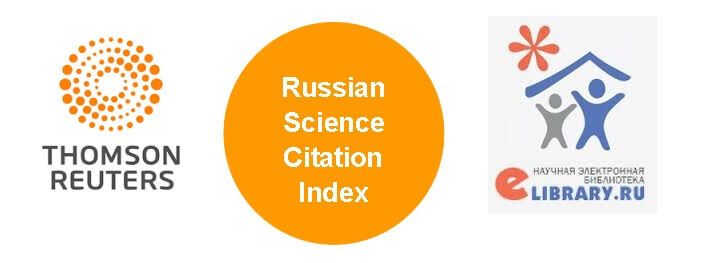Influence of external influences on the activation of domain walls of ferroelectric perovskites
Abstract
Purpose: The article aims to establish the regularities of the influence of external influences (thermal and electrical) on the activation of domain walls in oxygen-octahedral-type ferroelectric materials with perovskite structure which have a wide application in electronic devices. One of the problems in this case is the stability of domain walls with respect to external influences. With this in mind, the aim of the paper is to determine the activation energy of irreversible motion of domain walls when switching the polarization of a ferroelectric by electric field in a wide temperature range.
Experimental: The value of the critical energy Wmax of interaction of ferroelectric domains with an external electric field necessary for irreversible change of the domain structure of a ferroelectric under different thermal conditions is determined. For this purpose, the dielectric hysteresis loops P(E) of samples obtained at different temperatures were analyzed. Ferroelectric materials with oxygen-octahedral perovskite structure were chosen as objects of study: BaZrO3/BaTiO3 superlattice, Pb(Zr0.3Ti0.7)O3, ceramics (Pb0.96Sr0.04(Mg1/3Nb2/3)0.275(Ni1/3Nb2/3)0.1Ti0.375Zr0.25O3 and ceramics Pb0.88Ba0.06Sr0.06(Mg1/3Nb2/3)0.37Zr0.375Ti0.255O3).
Conclusions: Temperature dependences of the critical energy Wmax of interaction of ferroelectric domains with an external electric field necessary for irreversible change of the domain structure of a ferroelectric have been determined. The assumption that the energy Wmax has the meaning of the activation energy of the domain structure of a ferroelectric at switching of polarization by an electric field, necessary for irreversible change of its domain structure, has been substantiated. It is established that the critical energy Wmax decreases linearly with temperature in a wide temperature range below the Curie point. The obtained results have scientific and practical value, since they allow to determine the conditions of stability
of the domain structure of a ferroelectric to external influences and expand the possibilities of application of the Sawyer-Tauer method for determination of activation energies of irreversible change of the domain ferroelectric structure
Downloads
References
Kuzenko D. V. Temperature-activation mechanism of the temperature dependence of the dielectric constant of ferroelectric ceramics PZT. Journal of Advanced Dielectrics. 2022; 12(3): 2250010. https://doi.org/10.1142/S2010135X22500102
Zhang X., Wang B., Ji Y., … Nan C.-W. First-principles calculations of domain wall energies of prototypical ferroelectric perovskites. Acta Materialia. 2023;242: 118351. https://doi.org/10.1016/j.actamat.2022.118351
Gridnev S. A., Popov I. I. Kinetics of phase transformation at the Curie point of ferroelectric ceramic Ba0.8Sr0.2TiO3. Ferroelectrics. 2020;561(1): 127–134. https://doi.org/10.1080/00150193.2020.1736925
Sidorkin A. S., Nesterenko L. P., Sidorkin A. A., Matveev N. N. Effect of sample thickness on the mobility of domain walls in thin ferroelectric films of lead zirconatetitonate and lead titanate. Bulletin of the Russian Academy of Sciences: Physics. 2013;77(8): 1038–1040. https://doi.org/10.3103/s1062873813080388
Durdiev D., Zaiser M., Wendler F., … Uranagase M. Determining thermal activation parameters for ferroelectric domain nucleation in BaTiO3 from molecular dynamics simulations. Applied Physics Letters. 2024;124: 132901. https://doi.org/10.1063/5.0187476
Pramanick A., Prewitt A. D., Forrester J. S., Jones J. L. Domains, domain walls and defects in perovskite erroelectric oxides: a review of pPresent understanding and recent contributions. Critical Reviews in Solid State and Materials Sciences. 2012;37(4): 243–275. https://doi.org/10.1080/10408436.2012.686891
Warren W. L., Vanheusden K., Dimos D., Pike G. E., Tuttle B. A. Oxygen vacancy motion in perovskite oxides. Journal of the American Ceramic Society. 1996;79(2): 536–538. https://doi.org/10.1111/j.1151-2916.1996.tb08162.x
Zhou X., Liu Z., Xu B.-X. Influence of dislocations on domain walls in perovskite ferroelectrics: phase-field simulation and driving force calculation. International Journal of Solids and Structures. 2022;238: 111391. https://doi.org/10.1016/j.ijsolstr.2021.111391
Sidorkin A. S., Nesterenko L. P., Gagou Y., … Popravko N. G. Repolarization of ferroelectric superlattices BaZrO3/BaTiO3. Scientific Reports. 2019;9: 18948. https://doi.org/10.1038/s41598-019-55475-2
Chen X., Qiao X., Zhang L., … Geng W. Temperature dependence of ferroelectricity and domain switching behavior in Pb(Zr0.3Ti0.7)O3 ferroelectric thin films. Ceramics International. 2019;45: 18030–18036. https://doi.org/10.1016/j.ceramint.2019.06.022
Du G., Liang R., Wang L., … Dong X. Temperaturedependent ferroelectric dynamic hysteresis properties of modified PMN-PZT relaxor ceramics. Physica Status Solidi –Rapid Research Letters. 2013;7(6): 438–442. https://doi.org/10.1002/pssr.201307138
Wen B., Zhang Y., Liu X., Ma L., Wang X. Temperaturedependent ferroelectric hysteresis properties of modified lead zirconate titanate ceramics. Journal of Materials Science. 2012;47(10): 4299–4304. https://doi.org/10.1007/s10853-012-6280-y
Ishchuk V. M., Kuzenko D. V. F-centers mechanism of long-term relaxation in lead zirconate-titanate based piezoelectric ceramics. 2. After-field relaxation. Journal of Advanced Dielectrics. 2016;6(3): 1650019. https://doi.org/10.1142/S2010135X16500193
Kuzenko D. V., Bazhin A. I., Spiridonov N. A. Energy approach to the dependence of the parameters of ferroelectric ceramics (Pb0.95Sr0.05)(ZrхTi1-х)O3 on a DC electric field.Ferroelectrics. 2021;573(1): 76–86. https://doi.org/10.1080/00150193.2021.1890465
Smolensky G. A., Bokov V. A., Isupov V. A., Krainik N. N., Pasynkov R. E., Shur M. S. Ferroelectrics and antiferroelectrics. Leningrad.: Nauka Publ.: 1971. 476 p. (In Russ.)
Sidorkin A. S. Domain structure in ferroelectrics and related materials. Moscow: Fizmatlit Publ; 2000. 239 p. (In Russ.)
Yan H., Inam F., Viola G., … Reece M. J. The contribution of electrical conductivity, dielectric permittivity and domain switching in ferroelectric hysteresis loops. Journal of Advanced Dielectrics. 2011;1(1): 107–118 https://doi.org/10.1142/S2010135X11000148
Jaffe B., Cook W. R. Jr., Jaffe H. Piezoelectric ceramics. London and New York: Academic Press; 1971. 328 p.
Zhang L. L., Huang Y. N. Theory of relaxorferroelectricity. Scientific Reports. 2020;10: 5060. https://doi.org/10.1038/s41598-020-61911-5
Carreras-Casas C., García-Zaldívar O., Peláiz-Barranco A., González-Abreu Y., Calderón-Piñar F., Guerra J. D. S. Relaxor ferroelectric behavior: An approach considering both the dipolarand electrical conductivity contributions. Journal of Advanced Dielectrics. 2021;11(3): 2140008. https://doi.org/10.1142/S2010135X21400087
Sun E., Cao W. Relaxor-based ferroelectric single crystals: growth, domain engineering, characterization and applications. Progress in Materials Science. 2014;65: 124–210. https://doi.org/10.1016/j.pmatsci.2014.03.006
Ushakov A. D., Hu Q., Liu X., Xu Z., Wei X., Shur V. Y. Domain structure evolution during alternating current poling and its influence on the piezoelectric properties in [001]-cut rhombohedral PIN-PMN-PT single crystals. Applied Physics Letters. 2021;118(23): 232901. https://doi.org/10.1063/5.0055127
Misirlioglu I. B., Okatan M. B., Alpay S. P. Asymmetric hysteresis loops and smearing of the dielectric anomaly at the transition temperature due to space charges in ferroelectric thin films. Journal of Applied Physics. 2010;108(3): 034105. https://doi.org/10.1063/1.3457348
Sidorkin A. S., Nesterenko L. P., Ryabtsev S. V., Sidorkin A. A. Frequency dependence of the coercive field and the internal bias field in ferroelectric thin films. Physics of the Solid State. 2009;51(7): 1348–1350. https://doi.org/10.1134/s1063783409070075
Tagantsev A. K. Size effects in polarization switching in ferroelectric thin films. Integrated Ferroelectrics. 1997;16: 237–244. https://doi.org/10.1080/10584589708013046
Copyright (c) 2025 Kondensirovannye sredy i mezhfaznye granitsy = Condensed Matter and Interphases

This work is licensed under a Creative Commons Attribution 4.0 International License.













